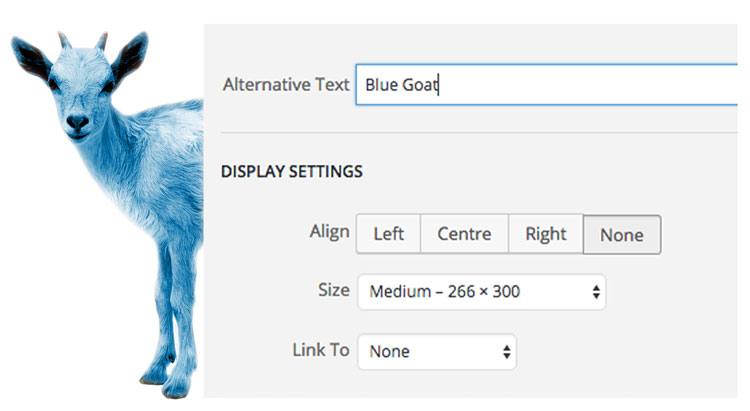When push comes to shove, you can get a business website up in a few hours, and I’m all for the ‘having something is better than nothing’ approach if it serves your business well. But with an organised approach, adding value to your small business website and getting good results from it should be the aim.
Having worked on dozens of sites over the last year, I’ve come up with some quick and easy wins for small business websites. They are easy to implement, and their impact is usually measurable within a few short months.
1. Connect your newsletter database to your website
Ok, so this might seem like a no-brainer. But something I have seen over and over when people launch a new site (or start grumbling about their old one) is that they are not offering their visitors any way to keep up to date with them. Sure, not everyone will leave their email address, but knowing that someone is interested in your brand, service, or product is basically impossible unless you give them the opportunity to tell you.
How:
Whatever platform you’re using, you should have access to a form or popup to connect to your mailing list software of choice. For an easy, no fuss implementation, use MailChimp and SumoMe to get started.
2. Provide a thank you page for your form redirects
No one likes a dead-end! When someone does subscribe to your site email list, make them feel welcome by thanking them on a purpose-built page, and letting them know where they can find the best content on your site.
How:
Depending on the software you are using, there are a number of ways to achieve this. Usually you are looking for an option to ‘URL redirect’ where you can insert the direct link to your pre-built thank you page.
3. Optimise at least 5 pages for keywords
I hate to be the one to say ‘I told you so’; but if you don’t actively optimise your site pages for Search Engines, you are not going to see any growth in organic searches. It doesn’t matter how beautiful your website looks. If it’s not indexing well in Google, then the only people who’ll know about it are those you tell personally.
The good news is that SEO doesn’t have to be overwhelming: I recommend that my clients start with the top 5 pages on their site they want to get found. Following a simple, proven method,carefully tweak your content on those pages to Google’s best standards and you should start to see gradual improvements.
How:
There are a couple of wonderful DIY resources out there to learn how to optimise individual pages, but your best bet is using a checklist and getting up close and personal with your content – here are my a few of my favourites:
4. Connect your site to Google Search Console
Google is big. Like really BIIIIIIIII…GGGG. And your website is a tiny, tiny little speck amongst it so you want to give yourself the best possible chance of being found right? And, if your site has some kind of error that stops it from being found, you’d want to know that too right? Oooh, and you want to know what people are searching to find your site too I bet…
Well this tip is for you. Connecting your site to Google Search Console (previously Webmaster Tools) will allow you to do all these things.
How:
Once you’ve created your Google Analytics account, head over to Google Search Console and connect the 2 accounts together. Then, submit your sitemap, hit ‘fetch as google’ and check for any errors.
Using WordPress? Check this out:
How to submit a WordPress XML Sitemap to Google
5. Publish a new piece of content every month (or more!)
This one takes planning and discipline but it is so valuable. Why? Well, lots of reasons but here are the top three for small businesses:
1) Google loves new content
2) It gives you an opportunity to talk to your customers in your own voice, and finally
3) It’s the perfect platform for creating targeted, timely and Search Engine Optimised pieces of content for your audience.
How:
The best way to get started with publishing regularly is to brainstorm possible topics in advance and use a content publishing template to structure your article. Writing about things you’re passionate about is also easier than coming up with entirely new ideas, so go easy on yourself and get comfortable pressing that publish button.
6. Optimise images on your site for both search engines and page load
I’m a nag. I’m an alt text nag. Anyone who’s ever attended one of my WordPress training sessions will have it drilled into them that if you’re going to have images on your site, then they may as well earn their keep. I insist each image is optimised for web use, and has alt text (alternate text) included.

Having alt text applied to your images serves a few purposes:
1) Google doesn’t see images, it just sees code, so unless your website tells google ‘alt=”Blue goat”, it ain’t seeing no goat!
2) Accessibility. As the internet evolves, it should be accessible to all. Screen readers read alt text to tell a vision impaired audience what is on the page. No alternate text, no goat… Got it?
3) SEO – yep – alt text is a hot on-site SEO element and can add to the integrity of a Google result for your keyword or phrase.
How: Applying alt text via html is pretty simple, but could be time consuming. I prefer to get into good habits and every time I upload an image, I make sure there is alt text added. And whenever you are creating images for your site, upload at an internet optimised size from your software of choice, the faster the load speed, the happier Google is to serve your content to the world.
7. Be consistent with your branding and colours
Whether you’re a one-person operation or a team of 50, your business branding is important. Being consistent in the application of your branding across both your onsite and offsite platforms will aid your clients in recognising your business and reinforce your professionalism.
How:
Good news. You don’t have to hire a designer every step of the way. My best tip is to establish a base style guide when you initiate your branding. Then, DIY the rest using tools like Canva for Work, where you can output standard image sizes for things like Facebook and Google, and also set up branding templates containing your logo colours, business fonts, image treatments etc.
Tools like Frontify also help us communicate our brand and style guide to other colleagues and stakeholders so that there is no dilution of the brand over time.
8. Connect your website to your Google Local My Business page
Looking to give your local search traffic a significant boost? The answer could be as easy as signing up for Google My Business Page.
Google My Business ensures your business pops up in Search, Maps and Google+ – so your customers know exactly where you are and how to make contact with you. Sounds pretty good, right?
How:
Head to google.com and click the “Get on Google” button at the top of the page. You will be prompted to submit information about your business with the service going live once you have verified your business.
9. Share your content across multiple platforms
Knowing where your audience is trying to find you is critical to any digital marketing you do. Even if you’ve just started to write a blog, knowing how to get in front of potential customers is important. The best way to do this is to publish your content to different avenues. Personally, I post everything to Twitter, LinkedIn, Facebook and Google +, But your audience could be hanging out in a variety of different social media and content marketing spaces. Get your content to them; don’t wait until they come to you!
How:
This could be a whole post in itself – in fact it is! Head over to Kissmetrics to ready this rad article on how to get your content out there:
https://blog.kissmetrics.com/double-your-social-media-traffic/
10. Use Good Quality Images. Always.
Nothing lets a perfectly designed website down more than atrocious imagery. Seriously, in a highly saturated online market, there is no space for blurry, muddy, dated, embarrassing images. These simply don’t cut it. And they shouldn’t. Because there are so many ways you can get good images on your site, and it doesn’t have to cost a lot.
How:
So, the best option is always to use professional photography. But, we don’t all have this luxury. I do recommend you get a professional portrait taken of yourself for use on about pages and the likes but it is optional.
Second to having your own photography at hand is using stock photography that you can purchase on a per-use basis.
Third, there are dozens of amazing repositories for obtaining stock photos legally, and free of charge.
To get you started, here’s a list.
Warning: Do not use images on your website that you haven’t licensed, don’t know the origin of or are unsure if you’re allowed to. It’s just not worth it – here’s why.
To wrap up
There are so many ways to improve the content, the engagement, the SEO and the aesthetics of your site, hopefully I’ve presented a number of ways you can improve your website in just a few clicks.
I’d love to hear your feedback, and your own easy wins for small business websites.
Source: 10 Easy Wins for Small Business Websites – WP Elevation








